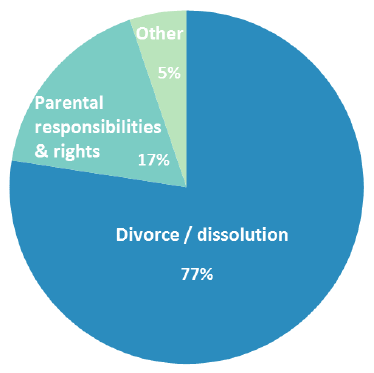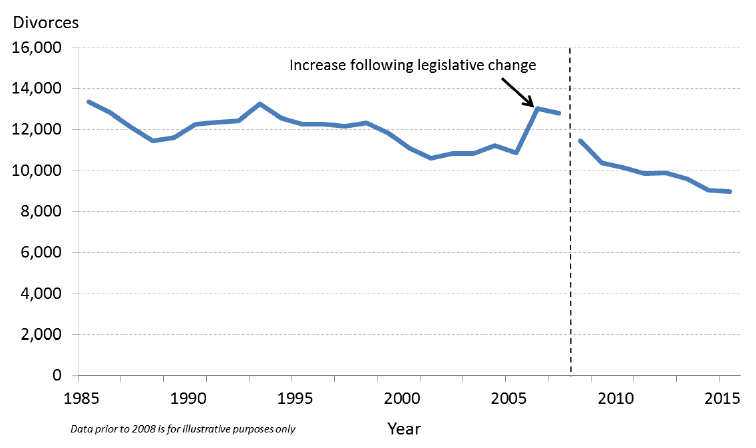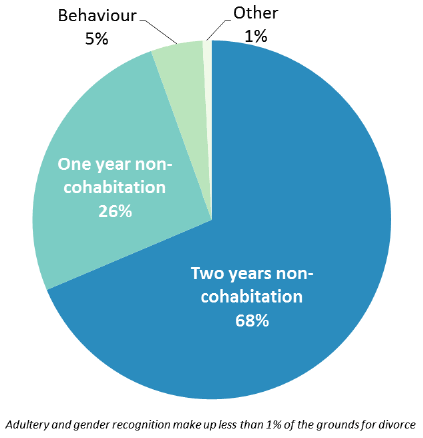Civil justice statistics in Scotland: 2015-2016
Statistics on civil justice, which aims to resolve a range of disputes from debt and eviction to divorce.
This document is part of a collection
6. Family
Divorce and dissolution made up 77% of family cases in 2015-16
Nearly all of the 8,875 divorces granted in 2015-16 were heard in sheriff courts, and 62% used the simplified procedure
Family law in Scotland
Family law covers a wide range of areas related to families, couples and children. These include divorces and dissolutions when relationships break down and couples decide to separate; applications relating to parental responsibilities and rights; and permanence and adoption cases.
Family law also covers interdicts preventing a party from making specific contact or coming within close proximity to another, and exclusion orders that suspend the rights of an individual to live in the family home. Family procedure cases made up 17% of all civil court cases initiated in 2015-16 ( Table 5, Table 1).
This section also contains statistics on sheriff court summary applications relating to adoption and children's hearings.
Scottish Crime and Justice Survey
In the 2014-15 Scottish Crime and Justice Survey, 2% of respondents experienced problems to do with the behaviour of a partner, ex-partner or other person harassing them, 1% experienced a problem to do with child contact, residence or maintenance and 1% experienced problems to do with divorce or separation.
Various vulnerable groups were more likely to experience at least one of the above three problems. For example, those living in in one of the top 15% most deprived areas in Scotland suffered a higher prevalence (6%) compared to the rest (3%). Those living in rented (as opposed to owner-occupied) accommodation were also more likely to have experienced one of these problems: 7% for social tenants and 5% for private tenants as opposed to 2% for owner-occupiers. Victims of crime also had a higher prevalence (7%) than non-victims (3%).
Among those who experienced at least one of the above three problems and considered them to be most important, half (51%) had already solved the problem, while 34% were still trying to solve it. 28% had sought help or advice from others excluding from family or friends and over half (60%) had made contact with a solicitor [8] for help.
Courts statistics - overview
Divorce is the formal procedure that ends a marriage, while the procedure for ending civil partnerships is known as dissolution. In addition to divorce and dissolution, the courts can also take decisions on where a child should live when parents separate; whether the non-resident parent should have contact with the child and who should have parental responsibilities and rights. Where children are involved, or there is a claim for financial provision, the ordinary procedure is used. However, the majority of divorces and dissolutions use a simplified procedure which is low-cost and simpler.
The courts statistics presented in this bulletin relate only to the principal crave of the case. This means that the statistics on certain case types, such as contact and residence, do not reflect the true number of actions brought to court as these issues are often ancillary craves in a case where the principal crave is for divorce. The feasibility of publishing statistics on ancillary craves in future editions of this bulletin is being investigated.
During 2015-16, 12,892 family cases were initiated in the civil courts and 11,442 were disposed of ( Table 5). Since 2008-09, there has been the same steady decrease of 13% in both the number of family cases initiated and disposed of. Divorce / dissolution and parental responsibilities and rights are the biggest case types and together account for 95% of family cases initiated ( Figure 7).
Figure 7: Family cases initiated in the civil courts, 2015-16

Does not add to 100% due to rounding
Court of session
Only a small proportion of family cases are heard in the Court of Session (1% in 2015-16). In 2015-16, 137 family cases were initiated in the Court of Session, representing 5% of cases in the General Department of that court ( Table 6). Divorces and dissolutions accounted for 89% of family cases initiated in the Court of Session.
Sheriff courts
There were 12,755 ordinary cause family procedure cases initiated in the sheriff courts during 2015-16, a decrease from the 13,457 cases initiated in 2014-15 ( Table 7, Civil Justice Statistics in Scotland 2014-15 Table 7). The majority were divorce and dissolution cases, which made up 77% of initiated family cases. In 2015-16, 96% of disposed divorce and dissolution cases were undefended, unchanged from the previous year. Decree of divorce or dissolution was granted in the vast majority of cases. Further information on divorce and dissolution cases can be found in the next section.
The majority of the remaining family cases initiated in 2015-16 related to parental responsibilities and rights. Within this category, the 1,039 contact cases were the most common. It should be noted that this statistic relates only to cases where contact is the principal crave. As in previous years, relatively few parental responsibilities and rights cases were disposed of in 2015-16 compared to those initiated (1,610 disposed of and 2,232 initiated). One possible explanation is that these cases can be sisted (suspended) while sheriffs seek further information, and parties may resolve their issues outside court during this time. These cases are not then brought back to court for disposal.
As detailed in the Recent changes to civil legislation section, the introduction of the Children's Hearings (Scotland) Act 2011 has resulted in changes to court business relating to children's hearings reported in Table 8. The Act was implemented in June 2013, and while the statistics for "extend/vary interim order" (previously referred to as child in place of safety) and children's hearings "referral" and "appeal" are based on similar definitions to those used for equivalent statistics previously, caution should be exercised when making comparisons between before and after those changes took effect. The statistics for the category "Children's Hearings Act 2011 - Other" have no direct equivalent.
In 2015-16, the vast majority (90%) of applications to extend/vary an interim order disposed of were granted. Similarly, most children's hearings - referral applications were granted and established the grounds for referral, with the case being referred back to the Children's Hearing to dispose of the case.
The number of adoption petitions has been relatively stable in recent years. In 2015-16 there were 496 such cases initiated. In contrast, the number of applications initiated for permanence orders with authority to adopt has been rising steadily, and reached 365 in 2015-16. The disposals of adoption petitions and permanence orders with authority to adopt show a similar pattern with nearly all these applications being granted (98% and 95% respectively).
Divorce and dissolution of a civil partnership
Divorce is the formal procedure that ends a marriage while the procedure for ending civil partnerships is known as dissolution.
The Civil Partnership Act 2004 came into force on 5 December 2005, allowing legal relationships between two people of the same sex to be formed. The first civil partnerships in Scotland were registered on 20 December 2005.
Divorce and dissolution cases can be raised in either the Court of Session or the sheriff courts. Since 1984, most divorce cases in Scotland have been heard in the sheriff courts.
There are two grounds for divorce, which are:
- The irretrievable breakdown of the marriage, which can be established by:
- Adultery committed by the defender;
- Unreasonable behaviour by the defender;
- One year non-cohabitation and the defender consents to the divorce;
- Two years non-cohabitation if one party doesn't agree to the divorce.
- Either party being issued with an interim gender recognition certificate.
The grounds for dissolution of a civil partnership and means of proving irretrievable breakdown are similar to those for ending a marriage, although adultery does not establish the irretrievable breakdown of a civil partnership. Same-sex unions from other jurisdictions were not recognised in Scotland until the Civil Partnership Act 2004 came into force and so no dissolutions were possible until then.
Divorces and dissolutions can be applied for using two main procedures in the courts - simplified procedure and ordinary procedure. The simplified procedure is a low-cost, simple method of obtaining a divorce/dissolution in cases where there are no children under 16 and no monetary claims by one spouse or partner against another [9] . Other cases go to court under the ordinary procedure.
The latest data on marriages and civil partnerships registered can be found in the Marriages and Civil Partnerships section of the National Records of Scotland website.
On 12 March 2014, The Marriage and Civil Partnership (Scotland) Act 2014 received Royal Assent. Following this Act, the first same-sex marriage ceremonies took place in Scotland on 31 December 2014. In addition, couples in civil partnerships are able to change their relationship into a marriage.
Divorce and dissolution statistics
Statistics on divorce and dissolution of a civil partnership were previously presented in the Divorces and Dissolutions in Scotland bulletin. The final bulletin in that series presented information about divorces and dissolutions in 2009-10. Statistics for 2010-11 and onwards have been included in the Civil Justice Statistics in Scotland bulletin series.
The divorce and dissolution statistics presented in Table 9 and Table 10 are based on different Scottish Courts and Tribunals Service data than the other statistics in this bulletin. See the section on Divorce and dissolution data sources for more information.
Further statistics, broken down by characteristics such as age at marriage/partnership, age at divorce/dissolution, duration and form of marriage/partnership, are available on the Civil Justice Statistics in Scotland datasets website within the Divorces & Dissolutions Supplementary Tables.
The number of divorces has been slowly decreasing from around 13,300 in 1985 to 8,875 in 2015-16 ( Figure 8) [10] . The main exception to this trend was a sharp rise in divorces in 2006. This rise can be attributed to the reduction in non-cohabitation periods required to prove irretrievable breakdown of a marriage brought into force by the Family Law (Scotland) Act 2006.
The total number of divorces granted in Scotland in 2015-16 was 8,875, 2% less than in 2014-15 (9,036) ( Table 9). In 2015-16, 62% of divorces granted used the simplified procedure and 38% used the ordinary procedure.
There were 96 civil partnership dissolutions granted in 2015-16, up from 81 in 2014-15 ( Table 10). The vast majority of dissolutions granted in 2015-16 (94%) used the simplified procedure.
Figure 8: Downward trend of divorces since 1985

Figure 9 shows the proportion of divorces that were granted in 2015-16 for different reasons [11] . Non-cohabitation for two years (68% in 2015-16) and non-cohabitation for one year with consent (26% in 2015-16) were the two most common reasons for divorce ( Divorces & Dissolutions Supplementary Table 2). These proportions have not changed much since 2010-11.
Figure 9: Divorces granted by reason, 2015-16

Contact
Email: Jeremy Darot
There is a problem
Thanks for your feedback